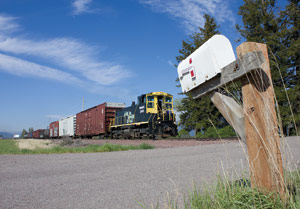COLUMBIA FALLS – For most people, Mondays are never easy. But few have ever had to deal with the daunting task that Levi Hubler and Dyllan Vincent faced last week after BNSF Railway left 40 freight cars for the Mission Mountain Railroad to deliver to various Flathead Valley industries that same day.
That workload is now common for the short line railroad that runs between Columbia Falls and Kalispell (as well as Stryker and Eureka), which has seen a boost in traffic this year, according to general manager Kyle Jeschke. Beginning in 2005, the Mission Mountain began running trains on tracks that a larger railroad had almost given up on. It’s on those tracks that Hubler and Vincent work, ensuring each rail car gets to the right place in a timely manner.
“It’s like a big game of chess,” Vincent said. “That’s exactly what it’s like and you can get really messed up if you make one wrong move.”
Rails first reached Kalispell in 1891 and back then it was part of the Great Northern Railway’s primary route from east to west. Years later, the railroad’s main line moved north, through Whitefish, and the line from Columbia Falls to Kalispell became a branch line. In 2005, BNSF leased the tracks to Watco Companies, which in turn created the Mission Mountain Railroad.
Over the last three decades, more short line railroads have begun operating sections of tracks that larger railroads no longer want. Because of the Staggers Rail Act of 1980, large railroads were able to get rid of unprofitable lines. By 2002, the short line railroad industry included 545 companies, operating more than 29 percent of the track in the United States, according to the American Short Line and Regional Railroad Association. Jeschke said smaller railroads don’t have as many employees and often are not unionized, which means it’s easier to cut costs.
Along the 14 miles of track between Kalispell and Columbia Falls, the Mission Mountain serves about a dozen industries, including Plum Creek and CHS Kalispell. In Lincoln County, the railroad owns 21 miles of track between Eureka and Stryker and serves two companies.
 |
|
A Mission Mountain Railroad freight train runs along U.S. Highway 93 near Evergreen last week. Justin Franz/Flathead Beacon |
Tom Ray, vice president of Northwest Resources and Manufacturing for Plum Creek, said having dependable rail service makes it easier for the lumber company to compete in other markets. The railroad can move product cheaper and further than trucks and, according to Ray, one rail car can move the same amount as three trucks.
“(The railroad) is a very good business partner and they are very responsive to our needs,” Ray said. “It would be very tough (without it) because when we ship long distances, rail is much more economic.”
On a busy day, Plum Creek can ship out more than 20 cars of lumber, plywood or fiberboard from its location in Columbia Falls or Evergreen. Moving cars for Plum Creek, the railroad’s largest customer, is one of Hubler and Vincent’s biggest chores when they get to work.
Before the two-person train crew can even start the railroad’s primary locomotive, it spends a few hours combing over the day’s paperwork. Every freight car has an identifying number and Hubler and Vincent have to make sure every car gets to where it needs to go. Most of the cars will be placed on the web of tracks inside the Plum Creek mill.
In 2008, serving the Plum Creek mill was the railroad’s primary purpose and with the lumber industry taking a hit, Jeschke said there was often only enough work for the two full-time employees. Today the railroad is back up to five people and, since last year, it is handling an average increase of 40 to 50 cars a month. According to marketing manager Scott Adams, the railroad now moves about 500 freight cars each month and, if the economy keeps growing, so too will the number of cars.
Another customer that is looking to increase the number of cars it ships by rail is CHS Kalispell, which loads up to 350 cars of grain a year, carrying 90 to 95 percent of the Flathead Valley’s grain harvest.
“It’s very important, we have to have it,” said CHS general manager Mark Lalum. “(The railroad) is a good way to get the grain out in an efficient manner and it helps the farmers keep their product moving.”
This year, CHS Kalispell and the railroad have been working together to ship grain in bulk, using 48-car unit grain trains. The longer train means a cheaper shipping rate and fewer trucks on area highways. Lalum is also hoping to begin loading grain brought up from Lake County.
“The Mission Mountain has done an excellent job and I have nothing but good things to say about Kyle and his crew,” Lalum said.
Jeschke said he hopes to expand the railroad’s business by working with the customers it already has. But even if the trains are getting longer, Jeschke admits it seems most people in the valley don’t always recognize the name Mission Mountain Railroad.
“I think some people think we’re BNSF,” he said, laughing. “But that doesn’t bother me, it’s nice to be under the radar.”